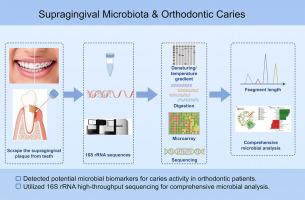Supragingival microbial profiles in caries-free and caries-active adolescents treated with fixed orthodontics
IF 5.8
Q1 MICROBIOLOGY
引用次数: 0
Abstract
Background
Dental caries occur primarily due to the formation of excessive dental plaque biofilm on teeth surfaces. This study aims to analyze the supragingival microbial profiles of permanent teeth in caries-free and caries-active adolescents with fixed orthodontic appliances and to identify bacterial biomarkers that may be indicative of caries activity in specific population.
Methods
Twelve-year-old adolescents treated with fixed orthodontic appliances were selected as the study population, with 5 caries-free and 5 caries-active subjects. Supragingival plaque samples were collected from the first permanent molars for the 16S rRNA high-throughput sequencing analysis of the V3-V4 region.
Results
There was no significant difference in alpha diversity and beta diversity between the caries-free and caries-active groups. LEfSe analysis showed that differentially abundant genera such as Selenomonas_3 (S. haemophilus, S. abiotrophia and S. streptococcus), Oribacterium, Dialister, and Olsenella species in the caries-free group, and Streptococcus mutans (S. mutans), Neisseria, Haemophilus, Granulicatella, and Abiotrophia species in the caries-active group, could be identified as potential biomarkers (P < 0.05). Co-occurrence network analysis revealed significant synergistic relationships among bacteria, with Streptococcusspp. displaying the strongest associations with other genera.
Conclusions
Increases in S. mutans and bacteria from the genera Neisseria, Haemophilus, Granulicatella, and Abiotrophia were strongly associated with the caries-active status of adolescents undergoing orthodontic treatment with fixed appliances. While increases in Selenomonas_3, Oribacterium, Dialister, and Olsenella were linked to caries-free status. These findings highlight the importance of managing the oral microbiome in adolescents with fixed orthodontic appliances, as certain bacterial species can serve as indicators of caries risk.

固定正畸治疗无龋和龋活跃青少年的龈上微生物特征
龋齿的发生主要是由于牙齿表面形成过多的牙菌斑生物膜。本研究旨在分析使用固定正畸矫治器的无龋和龋活跃期青少年恒牙的龈上微生物特征,并确定可能指示特定人群龋活跃性的细菌生物标志物。方法采用固定正畸矫治器治疗的12岁青少年为研究对象,其中无龋5例,龋活动5例。采集第一恒磨牙龈上菌斑样本,对V3-V4区进行16S rRNA高通量测序分析。结果无龋组和活跃龋组的α多样性和β多样性差异无统计学意义。LEfSe分析显示,无龋组的硒单胞菌(S. haemophilus、S. abiotrophia和S. streptococcus)、Oribacterium、Dialister和Olsenella种,以及龋活跃组的变形链球菌(S. mutans)、奈瑟菌(Neisseria)、haemophilus、Granulicatella和abiotrophia种等差异丰富的属可以被鉴定为潜在的生物标志物(P <;0.05)。共现网络分析显示细菌之间具有显著的协同关系,其中链球菌属。与其他属的关联最强。结论变形链球菌和奈瑟氏菌属、嗜血杆菌属、肉芽菌属、无营养菌属细菌的增加与使用固定矫治器进行正畸治疗的青少年龋齿活跃状态密切相关。而硒单胞菌_3、Oribacterium、Dialister和Olsenella的增加与无龋状态有关。这些发现强调了在使用固定正畸器的青少年中管理口腔微生物群的重要性,因为某些细菌种类可以作为龋齿风险的指标。
本文章由计算机程序翻译,如有差异,请以英文原文为准。
求助全文
约1分钟内获得全文
求助全文
来源期刊

Current Research in Microbial Sciences
Immunology and Microbiology-Immunology and Microbiology (miscellaneous)
CiteScore
7.90
自引率
0.00%
发文量
81
审稿时长
66 days
 求助内容:
求助内容: 应助结果提醒方式:
应助结果提醒方式:


